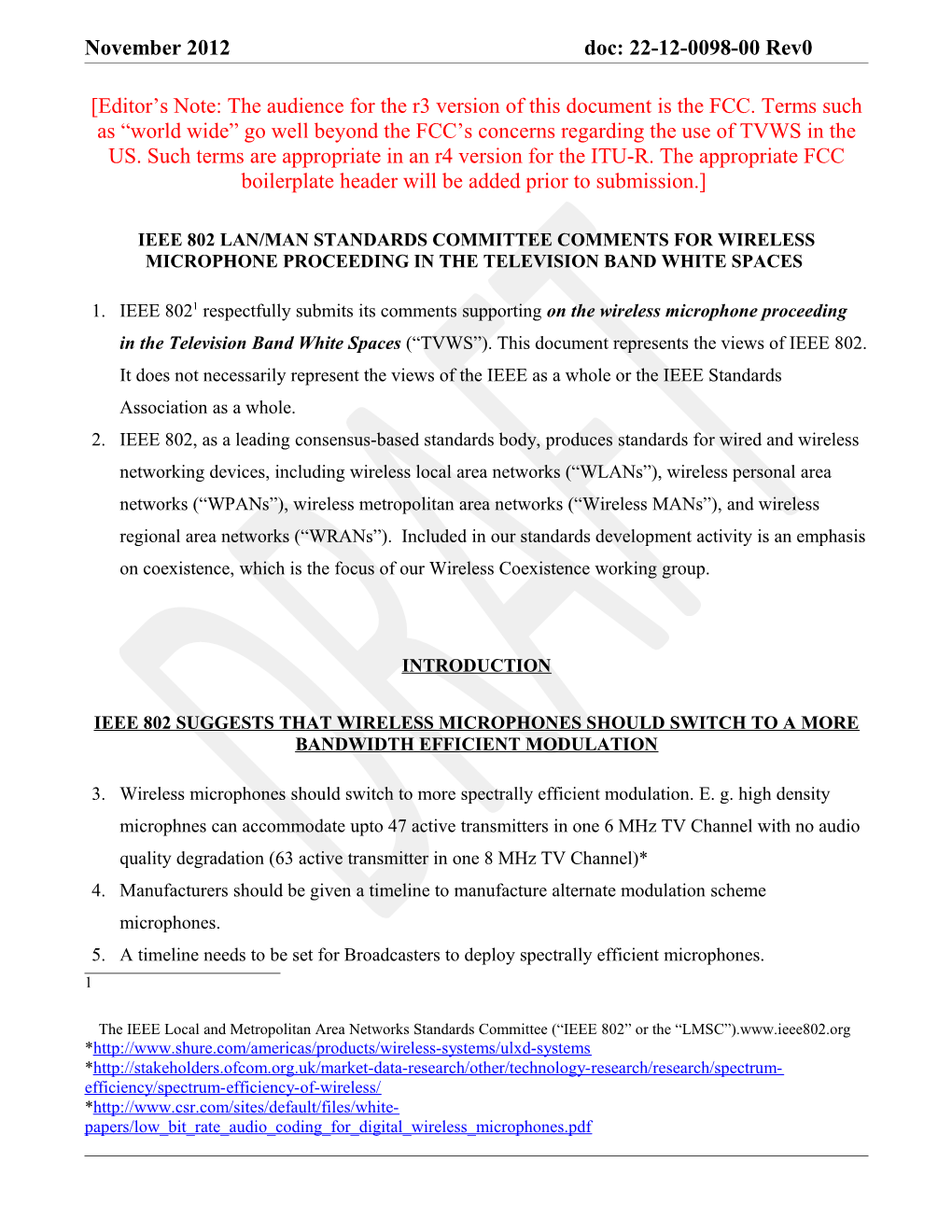November 2012doc: 22-12-0098-00 Rev0
[Editor’s Note: The audience for the r3 version of this document is the FCC. Terms such as “world wide” go well beyond the FCC’s concerns regarding the use of TVWS in the US. Such terms are appropriate in an r4 version for the ITU-R. The appropriate FCC boilerplate header will be added prior to submission.]
IEEE 802 Lan/Man Standards Committee CommentsFOR WIRELESS MICROPHONE PROCEEDING IN the television band whitespaces
- IEEE 802[1] respectfully submits its commentssupportingon the wireless microphone proceeding in the Television Band White Spaces (“TVWS”).This document represents the views of IEEE 802. It does not necessarily represent the views of the IEEE as a whole or the IEEE Standards Association as a whole.
- IEEE 802, as a leading consensus-based standards body, produces standards for wired and wireless networking devices, including wireless local area networks (“WLANs”), wireless personal area networks (“WPANs”), wireless metropolitan area networks (“Wireless MANs”), and wireless regional area networks (“WRANs”). Included in our standards development activity is an emphasis on coexistence, which is the focus of our Wireless Coexistence working group.
introduction
IEEE 802 SUGGESTS THAT WIRELESS MICROPHONES SHOULD SWITCH TO A MORE BANDWIDTH EFFICIENT MODULATION
- Wireless microphones should switch to more spectrally efficient modulation. E. g. high density microphnes can accommodate upto 47 active transmitters in one 6 MHz TV Channel with no audio quality degradation (63 active transmitter in one 8 MHz TV Channel)*
- Manufacturers should be given a timeline to manufacture alternate modulation scheme microphones.
- A timeline needs to be set for Broadcasters to deploy spectrally efficient microphones.
- Given the cost of replacing the current less spectrally efficient microphones, the FCC may consider compensating the broadcasters to accelerate the transition.
LICENSED PART 74, AND REGISTERED WIRELESS MICROPHONES USING SPECTRALLY EFFICIENT TECHNOLOGIES PROTECTION THROUGH DATABASE SERVICE
- Our statements below are applicable to all the Licensed Part 74 devices including wireless microphones, video assists, communications devices etc.
- We recommend that the Licensed Part 74 and registerd microphones using spectrally efficient technologies are provided protection through the TV Band database service.
- In case a Licensed Part 74 microphone is not utilizing that channel, then the channel could be made available for unlicensed WhiteSpace operation.
licensed part 74 WIRELESS MICROPHONES should be allocated to a channeladjacent TO THE EXISTING TV CHANNELS
- Digital microphones systems are 10 dB more resilient to interference than the analog systems. [OfCom reference]*
- Since according to the FCC Second Memorandum Opinion and Order, the fixed (4W) and portable (100 mW) WhiteSpace Devices cannot operate on the channels adjacent to the TV stations in a given geographical area, however they can operate next to a channel containing wireless microphones, it would be spectrally efficient, if a recommendation is made to the Database Service to allocate this adjancent channel for the operation of the Licensed Part 74 wireless microphone.
WIRELESS MICROPHONES WITH A WAIVER SHOULD be secondary to UNLICENSED WHITESPACE DEVICES that are part of the database service
- Since the wireless microphones with a waiver fall into the Part 15 category, they should abide by the Part 15 rules where they accept interference while do not cause interference to others.
- The Part 15 wireless microphones with a waiver should be treated secondary to unlicensed WhiteSpace devices that are part of the database service
UNLICENSED WIRELESS MICROPHONES WITH NO WAIVER SHOULD NOT BE ALLOWED TO OPERATE IN THE TV BANDS
- Unlicensed wireless microphones with NO waiver should not be allowed to operate in TV Bands
- If such unlicensed wireless microphones without a waiver do operate then WhiteSpace devices should not be responsible for any interference that may be caused to them
*
*
*
[1]The IEEE Local and Metropolitan Area Networks Standards Committee (“IEEE 802” or the “LMSC”).
